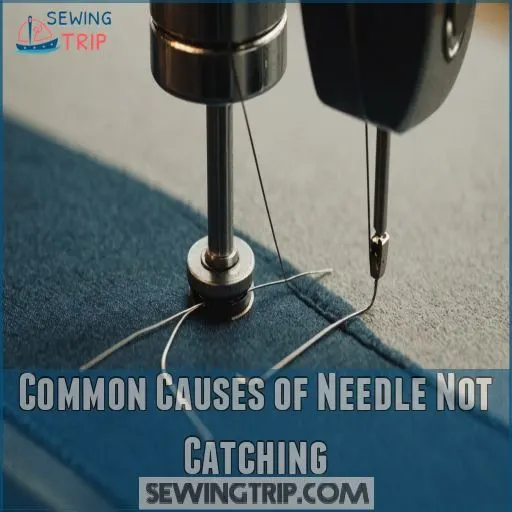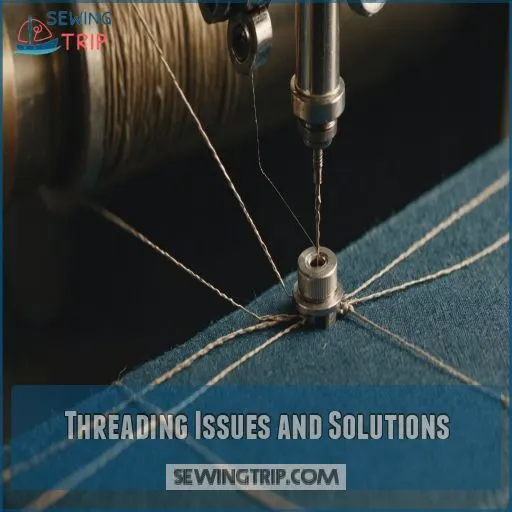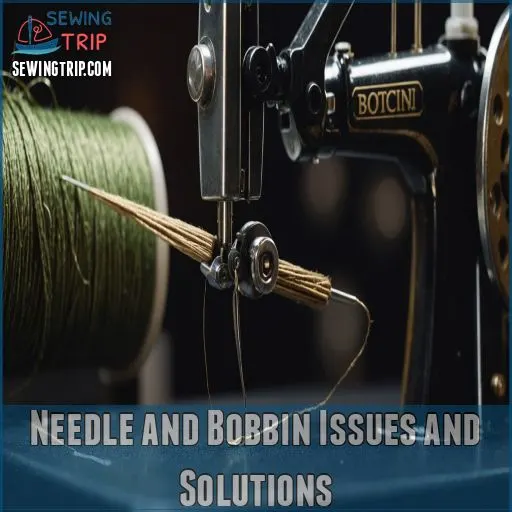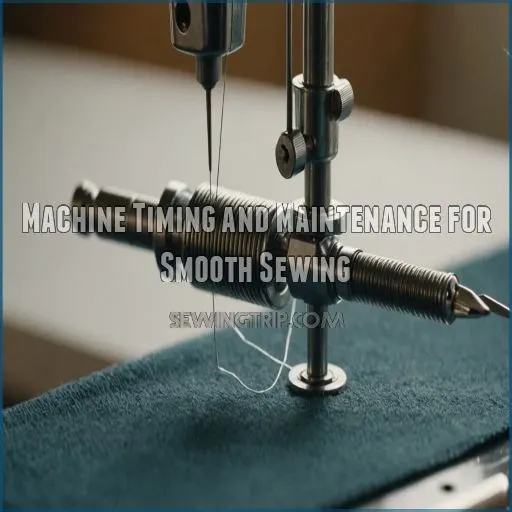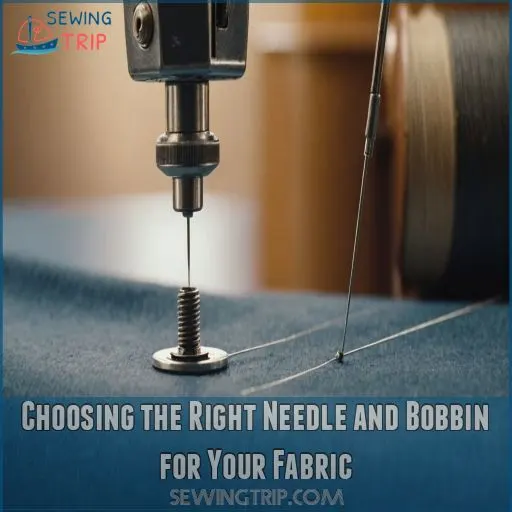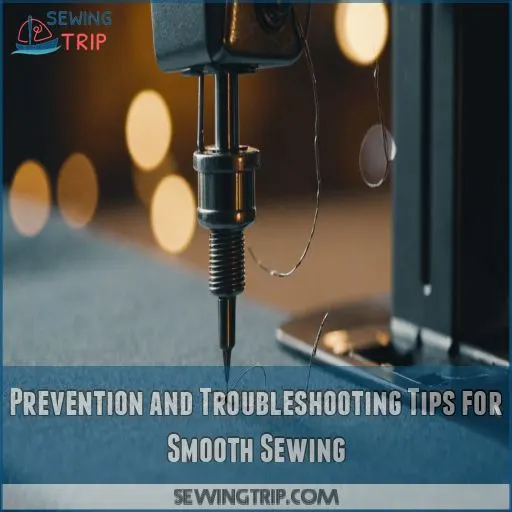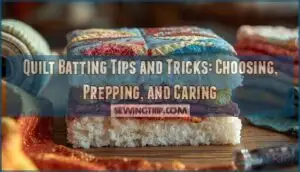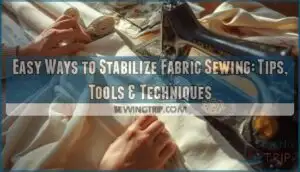This site is supported by our readers. We may earn a commission, at no cost to you, if you purchase through links.
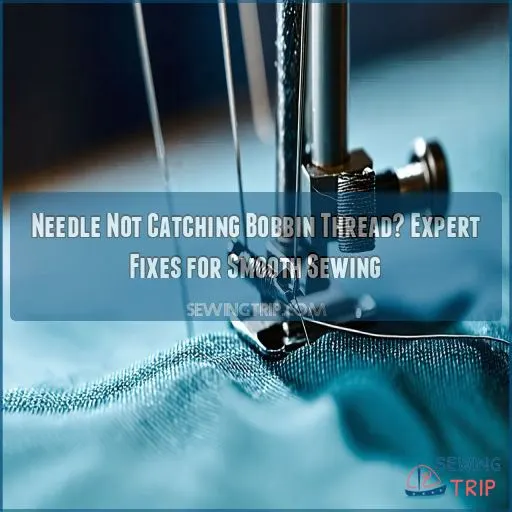 If your needle’s not catching the bobbin thread, it’s like trying to clap with one hand—frustrating, right?
If your needle’s not catching the bobbin thread, it’s like trying to clap with one hand—frustrating, right?
Start with the simple fixes: rethread the machine following the manual’s diagram, and make sure your bobbin is wound and installed properly. Check that your needle isn’t bent or damaged; a quick swap might do the trick.
Timing can also be a culprit, so consider if it needs adjusting.
Still perplexed? It might be a tension issue with the top or bobbin threads, needing fine-tuning.
Stick around as we unravel these knots with more practical sewing tips ahead.
Table Of Contents
- Key Takeaways
- Common Causes of Needle Not Catching
- Threading Issues and Solutions
- Needle and Bobbin Issues and Solutions
- Machine Timing and Maintenance for Smooth Sewing
- Choosing the Right Needle and Bobbin for Your Fabric
- Prevention and Troubleshooting Tips for Smooth Sewing
- Frequently Asked Questions (FAQs)
- Conclusion
Key Takeaways
- Check the Basics First: Make sure your machine is threaded properly by following the manual. A wrongly wound bobbin or a bent needle can throw everything off. It’s like trying to run a race with untied shoelaces!
- Mind Your Tension: Balance your thread tensions like a seesaw. If they are too tight or too loose, your stitches might start doing the cha-cha instead of keeping in line. Adjust them gently and see your fabric glide.
- Stay on Beat with Timing: If your needle is not catching, it could be a timing issue. Think of it as a dance where the needle and hook need to be perfectly synced. This might require a bit of patient tinkering.
- Regular Maintenance Pays Off: Treat your machine like a cherished car – clean it regularly, oil it as needed, and replace worn-out parts, like needles. This simple care is the key to a happy sewing experience, without the tangles and tantrums.
Common Causes of Needle Not Catching
If your sewing machine’s needle is doing the cha-cha instead of catching the bobbin thread due to a bent sewing needle, you’re in the right place
.
From a bent needle to misbehaving tension, let’s unravel the usual suspects causing this hiccup.
Improper Threading
Improper threading can make your sewing machine act like it’s throwing a tantrum!
Carefully follow the threading basics, or your needle mightn’t catch the bobbin thread.
Check the top thread path, and make sure your bobbin is wound correctly.
Thread tension and the shuttle hook’s alignment are very important.
Precision here prevents threading chaos while winding bobbins.
Incorrect Bobbin and Bobbin Case Installation
Ever struggled with thread jamming? Incorrect bobbin and bobbin case installation could be the culprit. Make sure the bobbin fits snugly and isn’t bouncing around like a toddler on sugar.
Try these steps:
- Align the bobbin case correctly.
- Double-check the bobbin winding.
- Use compatible bobbin case types.
- Keep the bobbin area clean for smooth sewing.
Tension Problems With Top and Bobbin Threads
While incorrect bobbin installation can cause headaches, tension problems play a sneaky role in the needle not catching the bobbin thread.
Imagine tension like a sewing seesaw—too tight or too loose, and your stitches tumble.
Adjust the top thread and bobbin thread tensions for balanced tension.
Don’t let fabric thickness throw a wrench in your stitch formation!
Bent or Damaged Needle
Skipped stitches making you pull your hair out?
Check if your needle’s bent or damaged. A simple needle replacement can work wonders!
A bent needle often won’t catch the bobbin thread properly. Choose the right needle size and type.
Regularly inspect needle condition and update as needed. Before you know it, your sewing woes will be a thing of the past with a simple needle replacement!
Timing Issues Between Needle and Hook
When your sewing machine refuses to catch the bobbin thread, timing issues might be the culprit, which can be addressed when you set the thread tension correctly
.
Pay attention to hook alignment and needle movement. Turn the handwheel slowly to check timing.
If the needle bar height is off, it disrupts hook timing and machine calibration.
Remember, mastering this is like coaxing a stubborn mule; it requires patience.
Fabric Thickness and Incorrect Needle Size
One common culprit? Your fabric thickness and needle size aren’t a match made in heaven.
Thicker fabrics like denim or upholstery need a sturdier needle, while delicate knits call for a ballpoint or stretch needle.
Check your needle gauge and match it to your project – it’ll make a world of difference in smooth, consistent stitching.
Threading Issues and Solutions
When the needle doesn’t catch the bobbin thread, it’s like misplacing your glasses and searching in vain.
Make sure your machine is threaded correctly by following the manual and adjusting the tension, saving yourself from a sewing headache.
Threading Diagrams and Machine Manual
Before blaming your machine’s tantrums on goblins, check those trusty thread tension basics sewing machine tension fixing in your sewing machine manual
.
They’re your best detective tool, helping you unravel mysteries like symbol meanings and diagram clarity.
Even if you have a vintage machine, most manuals are online. This way, you won’t stitch blindfolded, and troubleshooting diagrams become your best friend.
Correct Threading of Top and Bobbin Threads
Untangling threading woes doesn’t have to be a Herculean task.
Make sure your sewing goes smoothly with these steps:
- Use the threading diagrams to guide you correctly.
- Confirm the bobbin is properly wound and inserted.
- Check the thread path is clean and clear.
- Double-check needle size for compatibility.
With this, you’ll stitch in peace, not pieces.
Adjusting Upper Thread Tension and Rethreading
Got your threading spot on? Great!
Now tackle upper thread tension with confidence. Start by checking the tension dial, often misunderstood as a sewing monster.
Set it around 4 and sew a test line. If the stitch isn’t perfect, try rethreading to avoid threading mistakes. Sometimes, even a small tweak is all you need for tension troubleshooting!
Checking for Tension Issues in the Upper Thread Path
After adjusting your upper thread tension, it’s time to inspect the path for any hitches. A misstep here can make for a wild thread adventure!
Make sure the thread smoothly passes through:
- Thread Guides: Check each guide for obstructions.
- Tension Adjustments: Set the dial carefully.
- Rethreading Tips: Follow your manual religiously.
Smooth sailing awaits!
Avoiding Incorrect Threading and Tension Problems
When mastering threading, follow your machine’s threading diagram like a treasure map.
Keep that presser foot up or tension disks will misbehave. Adjust tension gently, like tuning a delicate instrument; too tight and your threads might break from the stress.
Remember, every misstep can feel like herding cats, so patience is your best friend.
Needle and Bobbin Issues and Solutions
Is your needle not catching the bobbin thread?
Don’t worry, we’ve got your back!
In this section, we’ll look at the common culprits and share expert fixes to resolve typical sewing machine problems fixing to get your sewing machine humming along smoothly
.
Checking for Bent or Damaged Needles
Check your needle to make sure your sewing goes smoothly. Often, a bent or damaged needle causes problems.
- Visual Check: Look for bends or burrs.
- Straightness Test: Roll the needle; wobbles mean trouble.
- Needle Type and Size: Match it to your fabric.
- Replacement Time: Swap needles regularly.
Turn that sewing challenge into a success story!
Replacing Needles With Correct Size and Type
Struggling with thread-stitch harmony? Swap your needle for perfection! The wrong size or type invites chaos. Consult a Needle Size Chart, choose a needle suited to your fabric, and let precision prevail.
To avoid issues, remember to replace your needle every 8-10 hours of use or when starting a new project, especially if you notice signs of a worn needle like a dull "thud" or "pop" sound, or skipped stitches. For more information on when to replace your needle, check your machine’s manual.
Got quilting dreams? Use quilting needles! Brands like John James offer variety to match every project. Let’s ace this sewing dance together!
| Needle Type | Ideal Fabric | Needle Gauge |
|---|---|---|
| Universal | Cotton, linen | 70/10 |
| Ballpoint | Knits, jerseys | 80/12 |
| Denim | Heavy fabrics, denim | 90/14 |
| Quilting | Multiple layers | 75/11 |
| Embroidery | Delicate threads | 75/11 |
Ensuring Correct Bobbin Case Installation and Maintenance
So, you’ve replaced your needles and are ready for smooth sailing.
Next, let’s make sure your bobbin case is snug as a bug. Make sure you’re inserting the bobbin case correctly and clean it regularly to keep things moving smoothly.
Don’t forget to check bobbin case tension and compatibility with your machine. Your sewing project will thank you for a job well done with proper bobbin case tension.
Using Correct Bobbin Size and Type for the Machine
After installing the bobbin case properly, use the correct bobbin size and type, matching your machine specifications. It’ll save you a bundle of frustration!
Consider checking the following to ensure smooth sewing:
- Bobbin compatibility: Verify with the manual.
- Machine specifications: Stick to recommended bobbin types.
- Thread compatibility: Make sure sewing goes smoothly without hiccups or tangles.
Ensuring Bobbin is Inserted Correctly and Wound Evenly
Imagine this: you’re stitching away, then bam! The thread tangles.
Insert your bobbin right! Always check bobbin winding consistency and make sure bobbin tension is spot on.
Refer to your machine manual for bobbin size selection and bobbin case compatibility—each machine’s unique (Source).
Wind the bobbin evenly to avoid hiccups, and you’ll be sewing smoothly in no time (Source).
Machine Timing and Maintenance for Smooth Sewing
Got a sewing machine that’s misbehaving and refusing to catch that bobbin thread?
Let’s tackle this by checking your machine’s timing and routine maintenance, so you can stitch with confidence and maybe sneak in a few extra minutes of sewing bliss.
Checking and Adjusting Timing Between Needle and Hook
Grab your timing check tools and let’s make sure that needle and hook are perfectly aligned.
If the hook’s passing above or below the needle’s eye, you’ve got timing issues.
No worries – just loosen those gears and make some manual adjustments until you nail that sweet spot.
Smooth sewing’s just a few tweaks away with some manual adjustments.
Regular Cleaning and Maintenance of the Machine
Your sewing machine’s a trooper, right? Keep it humming. Routine maintenance prevents breakdowns.
- Clean Regularly: Dust and lint are enemies. Regular cleaning also helps prevent issues like a sewing machine needle not moving, especially problems with the clutch engagement or drive belt. Checking the needle position and ensuring it’s inserted correctly can also go a long way in preventing machine problems.
- Use Proper Oil: Check your manual on lubrication.
- Check Parts: Look for wear and tear.
- Follow Schedule: Stick to a lubrication schedule for best results.
With care, your machine’s your best stitch buddy.
Cleaning the Bobbin Case, Shuttle Area, and Other Parts
After regular maintenance, get into cleaning the bobbin case and shuttle area. This step clears out pesky lint build-up, ensuring your machine runs like a dream.
Use small brushes and follow your maintenance schedule religiously. Trust me, a clean machine is a happy machine!
Keep those cleaning tools handy, and you’re on a roll.
Preventing Future Issues With Regular Maintenance
Think of sewing machine care as the secret sauce to smooth sewing.
A regular cleaning routine, sprinkled with preventative maintenance, keeps your machine in top shape.
Stick to an oiling schedule to treat it like a well-oiled machine—literally!
Troubleshooting tips become less frequent, and voila, you’ve mastered a happier, healthier sewing companion.
Choosing the Right Needle and Bobbin for Your Fabric
Choosing the right needle and bobbin might seem like pairing socks from the laundry, but it’s essential for a perfect stitch.
Grab the correct needle size and type for your fabric, and watch your sewing machine perform magic without missing a beat, following a simple sewing machine maintenance routine
.
Selecting the Correct Needle Size and Type for Fabric
Just as timing keeps your sewing in sync, selecting the right needle size makes sure harmony with your fabric. Examine needle types and consult a needle size chart to match your fabric weight with the appropriate sewing machine needles.
For instance, universal needles are suitable for a wide range of fabrics and thread thicknesses, making them a great starting point for beginners. Understanding Needle Size can also help determine the best needle size for your project.
An 80/12 is like Goldilocks—just right for many fabrics! Trust your needle gauge to sew happily ever after.
Considering Fabric Thickness and Choosing the Right Needle
You’ve picked the perfect needle size and type for your fabric.
Now, consider that trusty needle size chart again. Fabric thickness plays a big role.
For heavy fabrics, grab a sturdy needle with a higher gauge.
Needle types vary too, so match them with fabric types to avoid sticky situations.
Remember, the right choice makes all the difference!
Using a Walking Foot for Thick Fabrics and Quilts
Discover the magic of a walking foot for sewing thick fabrics and quilts.
This handy attachment moves the top and bottom layers evenly, preventing puckering or distortion.
Try it for:
- Quilting lines without drag or distortion
- Stitching stretch fabrics beautifully
- Sewing leather, vinyl, and upholstery
- Mastering plaid and stripe alignment
Prevention and Troubleshooting Tips for Smooth Sewing
Keeping your sewing machine running smoothly can feel like keeping a teenager’s room clean.
A bit of proactive maintenance and smart troubleshooting can save the day.
Whether you’re using prewound bobbins for consistency or simply need to adjust your thread tension, these tips will help you sew without stress.
Using Prewound Bobbins for Convenience and Consistency
Prewound bobbins are a lifesaver, saving you time and ensuring consistent tension.
Unlike hand-wound varieties, they’re perfectly wound, enhancing stitch quality and reducing bobbin changes mid-project.
Think of them as the fast-food equivalent of bobbins—quick, convenient, and dependable.
Store them in a cool, dry place to maintain their quality, and you’re good to go!
Avoiding Common Mistakes and Troubleshooting Techniques
Avoid threading blunders by following these techniques.
First, always double-check your machine’s manual for the correct thread path. Second, practice tension adjustments to avoid thread path issues.
Third, make sure your needle is the right type for your fabric.
These small steps can prevent headaches later.
Remember, maintain sewing machine maintenance to keep your projects running smoother than a hot knife through butter.
Maintaining a Smooth Sewing Experience With Regular Maintenance
To keep your sewing machine running like a well-oiled machine, stick to a regular maintenance schedule.
Clean it after every few projects to prevent lint buildup. Use light lubrication basics as per your manual—too much oil, and you might’ve a slip ‘n slide!
Such preventative measures enhance sewing machine care, ensuring a smoother sewing experience.
Experimenting and Being Patient With Solutions
You’ve mastered the basics of sewing machine care, but sometimes things still go awry.
When troubleshooting, patience is key. Think of it as a sewing dance: trial and error are your partners.
Avoid common mistakes by trying different solutions and embracing small victories.
It’s like taming a wild beast; it’ll yield with time and understanding.
Frequently Asked Questions (FAQs)
Why is my bobbin thread not catching?
Check if your bobbins is correctly inserted and wound tightly.
Re-thread the top thread, as it’s easy to miss steps.
Inspect the needle for bends or bends or trouble caused by the thickness of fabric might also cause trouble.
How to use a bobbin thread on a sewing machine?
Start by placing the wound bobbin in its compartment with the thread facing the right direction.
Thread your machine’s needle, then rotate the handwheel to catch the bobbin thread, creating a loop you can pull through.
How to pick bobbin thread?
To pick up the bobbin thread, lower the needle into the fabric.
Turn the handwheel manually, so the needle dips and lifts, looping the top thread around the bobbin thread.
Pull them out together gently.
Why is my sewing machine catching bobbin thread?
Your sewing machine snagging the bobbin thread feels like a skipped heartbeat, right? This could be due to incorrect thread tension, which can cause the needle to not catch the bobbin thread properly a common sewing machine issue
?
It might be misthreaded, misaligned, or simply dirty.
Try rethreading, checking bobbin placement, or cleaning the machine thoroughly to fix it.
Why is my needle not catching the bobbin thread?
Sewing machines sometimes miss the bobbin thread due to needle misalignment, incorrect threading, or a loose bobbin.
Double-check these elements.
If it’s still acting up, a timing adjustment might be needed, but don’t sweat it just yet.
How to get the bobbin thread to catch?
Reel in the problem like a pro – check your bobbin tension, threading, and needle size.
With a few quick tweaks, you’ll have that bobbin thread dancing to your tune in no time!
How does the needle catch the bobbin?
In a sewing machine, the needle catches the bobbin thread by forming a loop as it descends.
The rotating hook grabs this loop, intertwining both threads to create a stitch, kind of like a quick dance.
Why is my bobbin thread not looping?
Your bobbin thread might be dodging the hook’s embrace due to incorrect bobbin placement, unsuitable tension, or threading mishaps.
Double-check the bobbin case, tension settings, and threading path to make sure everything’s seated just right (Source).
How do you correctly align the bobbin?
Did you know improper bobbin alignment causes up to 30% of sewing issues?
To align it, make sure the notch in the bobbin case matches the correct spot in the machine, usually around the 5 o’clock position.
What tools are needed for regular maintenance?
Grab these essentials: a handheld brush, small brushes, and screwdrivers.
Add pipe cleaners and a magnetic screwdriver for tricky spots.
A touch of humor never hurts; think of it as a spa day for your machine!
Can thread quality affect sewing performance?
Thread quality can seriously impact your sewing game.
Poor threads lead to breakage, ugly seams, and frustration.
Imagine sewing like a kung fu master; perfect thread guarantees smooth moves, precision, and durability in every stitch.
How can humidity impact thread tension?
Humidity can play havoc with thread tension by making threads swell and stick, leading to inconsistent stitching.
Keep your sewing space dry, and consider using a dehumidifier for smoother, stress-free sewing sessions.
Are some machines more prone to bobbin issues?
Some sewing machines are more prone to bobbins issues due to factors like improper bobbin threading, tension problems, and incompatible needle and thread combinations.
Carefully follow your machine’s manual to avoid these common bobbins headaches.
Conclusion
Don’t let frustration get the best of you when your needle’s not catching the bobbin thread.
Instead, tackle it with confidence by checking your threading, needle condition, and timing. Remember, even pros face these hiccups, and following these tips will keep your sewing smooth.
Regular maintenance is key, and sometimes a fresh perspective can turn trouble into triumph. By keeping things simple and staying patient, you’ll have your machine purring along in no time.

